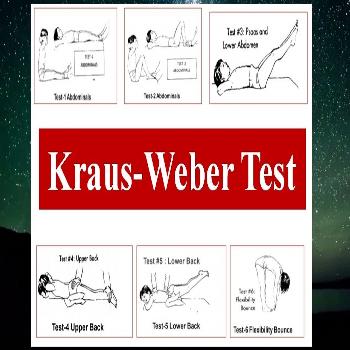Why would I need the Muscle Strength & Flexibility Screen / Kraus-Weber Test?
Assessing overall muscle strength: The test evaluates different muscle groups, providing insights into overall body strength and identifying weaknesses or imbalances.
Evaluating flexibility: It assesses the flexibility of the spine, hamstrings, and other muscle groups, helping to detect tightness or limitations that may affect physical performance or lead to injuries.
Fitness screening: Schools, sports programs, or fitness trainers may use this test as part of a comprehensive fitness evaluation to establish baseline levels of strength and flexibility.
Rehabilitation and injury prevention: Physical therapists and healthcare providers may use the test to identify areas that need improvement, guide rehabilitation programs, or prevent injuries, particularly in athletes or individuals recovering from injuries.
Measuring progress: The test can be used periodically to measure improvements in strength and flexibility over time, helping to monitor the effectiveness of training or rehabilitation programs.
What exercises are included in the Kraus-Weber Test?
The Kraus-Weber Test consists of six exercises designed to evaluate muscle strength and flexibility:
Exercise 1: Abdominal strength—The individual lies on their back with legs straight and attempts to lift their head, shoulders, and chest off the ground without assistance.
Exercise 2: Lower abdominal strength—While lying on the back, the individual lifts both legs off the ground while keeping them straight.
Exercise 3: Upper abdominal and psoas muscle strength—In a sitting position with legs straight and toes pointed up, the individual attempts to touch their toes without bending their knees.
Exercise 4: Lower back flexibility—While lying face down, the individual lifts their upper body (head, chest, and shoulders) off the ground without using their hands.
Exercise 5: Upper back and hamstring flexibility—The individual stands with feet together and bends forward, trying to touch their toes without bending their knees.
Exercise 6: Combined strength and flexibility of the core—Lying on the back with arms extended overhead, the individual performs a sit-up, bringing the arms forward to touch the toes.
Each exercise is scored based on the individual’s ability to perform the movement properly.
Do I need to prepare for the Kraus-Weber Test?
Preparation for the Kraus-Weber Test is simple but essential:
Wear comfortable, loose-fitting clothing that allows for a full range of motion.
Warm-up: Doing a brief warm-up, such as light stretching or dynamic exercises, is beneficial to prepare the muscles and joints for the test.
Stay hydrated and ensure you are well-rested before taking the test to perform at your best and avoid discomfort.
Consult with a healthcare provider or fitness professional if you have any pre-existing injuries or conditions that may be affected by physical exertion.
Proper preparation ensures accurate results and reduces the risk of injury during the test.
